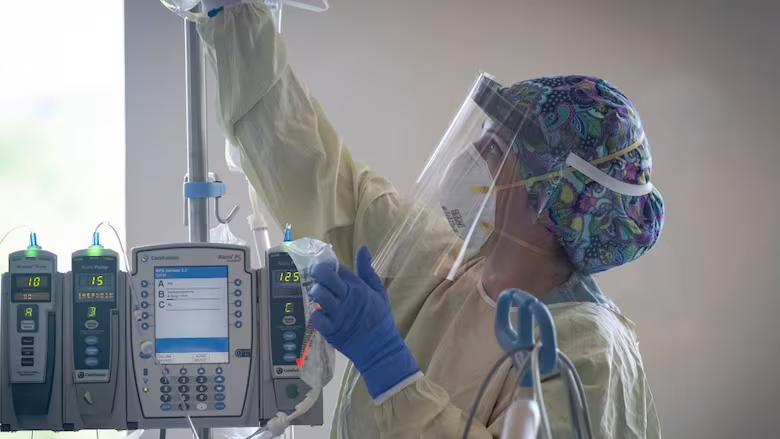Ontario reports 1,780 new COVID-19 cases, tightens restrictions in 3 regions
New COVID-linked deaths jump to 25 from 14 the day before

Ontario reported another 1,780 cases of COVID-19 and 25 more deaths from the illness on Friday, as the provincial government announced the members of its vaccine distribution task force.
The province also said three more regions are moving into new levels of the province's colour-coded restrictions framework for at least 28 days. York Region continued to avoid being placed in lockdown despite being among the hardest hit regions after Toronto and Peel.
As of Monday, Middlesex-London and Thunder Bay will be in the orange "restrict" tier, while the Haliburton, Kawartha, Pine Ridge District Health Unit will move into the yellow "protect" category.
"Over the last seven days we have seen the trends in key public health indicators continue to go in the wrong direction in these three regions," said Minister of Health Christine Elliott in a news release.
The new cases reported Friday include 633 in Toronto, 433 in Peel Region, 152 in York Region and 94 in Durham Region.
Other public health units that saw double-digit increases were:
- Windsor-Essex: 68
- Halton Region: 51
- Hamilton: 43
- Simcoe Muskoka: 41
- Waterloo Region: 40
- Middlesex-London: 39
- Ottawa: 36
- Wellington-Dufferin-Guelph: 25
- Niagara Region: 21
- Southwestern: 20
- Thunder Bay: 13
- Brant County: 11
- Huron Perth: 10
Also included in today's new cases are 129 that are school-related: 102 students and 27 staff members. Some 776 of Ontario's 4,828 publicly-funded schools, or about 16 per cent, currently have at least one case of COVID-19, while eight schools are currently closed because of the illness.
(Note: All of the figures used for new cases in this story are found on the Ontario health ministry's COVID-19 dashboard or in its daily epidemiologic summary. The number of cases for any region may differ from what is reported by the local public health unit because local units report figures at different times.)
Given today's figures, the seven-day average of new daily cases dropped slightly to 1,759.
There are currently 14,997 confirmed, active cases of COVID-19 provincewide, the most at any point since the outbreak began in late January.
They come as Ontario's network of labs processed 56,001 test samples for the novel coronavirus and reported a test positivity rate of 3.6 per cent. Another 62,400 tests are in the queue waiting to be completed.
Moreover, the number of patients in Ontario hospitals with confirmed cases of the illness climbed to 674. Of those, 207 are being treated in intensive care, though an internal Critical Care Services Ontario report puts the current total at 214 as of Friday morning. Some 116 are on ventilators.
The 25 additional deaths pushes the province's official toll to 3,737.
Vaccine task force members announced
Meanwhile, the province has appointed nine people to its vaccine panel, including the province's top coroner.
The panel, headed by retired chief of national defence staff Rick Hillier, will oversee distribution of the vaccine when available.
Health Minister Christine Elliott said it will be up to the panel to ensure effective and ethical delivery of a vaccine.
WATCH | Dr. Isaac Bogoch, a member of the vaccine task force, details his priorities:
Key tasks include delivery, logistics and administration, clinical guidance as well as public education and outreach.
The panel includes Chief Coroner Dr. Dirk Huyer, former Toronto police chief Mark Saunders, and Linda Hasenfratz, head of car parts giant Linamar.
LTC commission recommends annual inspections
Ontario's Long-Term Care Commission released its second interim report Friday morning, making seven more recommendations to the Progressive Conservative government.
The interim report, which comes amid surging cases, notes 100 homes have seen an outbreak in the last six weeks, with 300 more deaths.
Among them is a call to reintroduce comprehensive annual inspections, known as Resident Quality Inspections (RQI), which were eliminated by the province in the fall of 2018. The process required a minimum of one thorough, unannounced inspection each year.
Only 27 homes were inspected last year, far fewer than in previous years, the report states. Inspectors looked at only 11 of the province's 670 nursing homes proactively from March 1 after the pandemic hit to Oct. 15.
Inspectors issue mandatory orders only in "extreme circumstances," the report says, noting only 21 were handed out
between January 2019 and August 2020. Fines or prosecutions are "rarely applied," resulting in a "lack of urgency" from home operators to address violations.
CBC Marketplace reported in September that an analysis commissioned by the Ministry of Long-Term Care in 2015 concluded that RQIs were up to five times more effective than other types of inspections.
In a statement, Minister of Long-Term Care Merrilee Fullerton didn't specifically mention the issue of inspections but said the government has already moved to address many of the commission's ongoing recommendations.
"We have invested over $750 million to protect residents, caregivers, and staff in long-term care homes during the pandemic, and we will continue to act on the commissioners' recommendations to protect our most valuable.
With files from Lucas Powers and The Canadian Press
